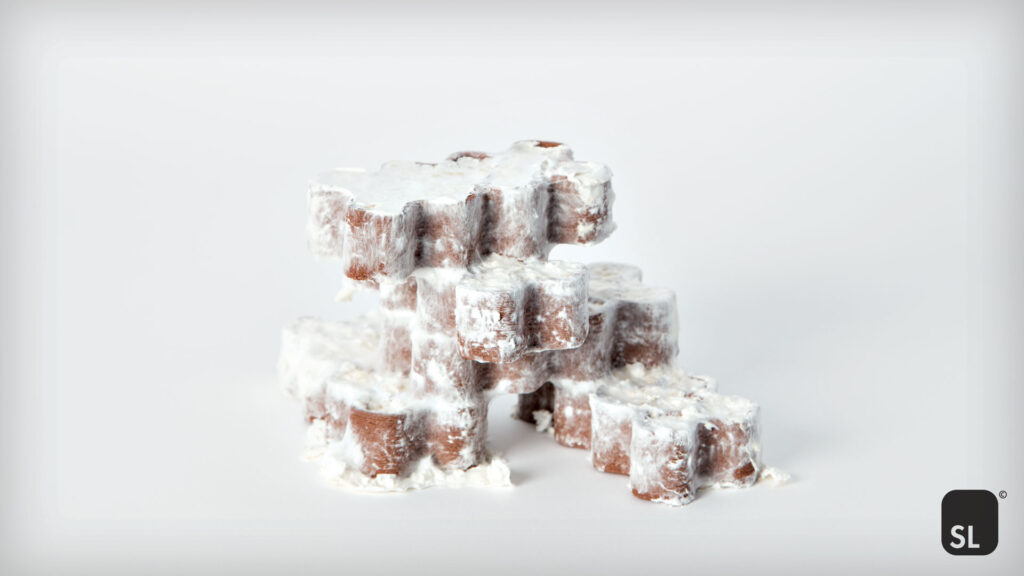The Institute of Architecture and Media at Graz University of Technology has recently released an intriguing paper titled “MyCera: Application of Mycelial Growth Within Digitally Manufactured Clay Structures.” The research team—consisting of Julian Jauk, Lukas Gosch, Hana Vašatko, Ingolf Christian, Anita Klaus, and Milena Stavric—presents a novel method of 3D printing clay, sawdust, and mycelium together. Mycelium, essentially the “roots” of fungi, stretches through soil and other organic materials, aids in the decomposition and absorption of nutrients for the fungi. This isn’t the first instance of mycelium’s application in construction or design. Fraunhofer IBP has leveraged it for sound-insulating structures, and various designers and researchers have explored its use as a biological scaffolding material.
In this study, the blend of mycelium (Pleurotus ostreatus), sawdust, and clay emerges as a highly sustainable building material. The researchers are using mycelium as a bio-based alternative to traditional reinforcing materials like glass fiber, commonly found in polymers. Here, the sustainable material acts as a fiber reinforcement to fortify the clay composite. The team envisions a future where components are “bio-welded,” meaning the mycelium would continue to grow within the structure, adding strength over time. This living reinforcement process would persist even after the structure has been constructed. In their experiments, mycelium accounted for 10% of the component’s weight, effectively creating a living structure of clay and fungi. This ongoing reinforcement also serves to bind together different parts of the component, raising the possibility of an ultra-slow 3D printing process where layers are interlocked by growing mycelium.
The team employed a Delta WASP 40100 Clay printer for their research, which reportedly resulted in a significant increase in the tensile strength of the finished component. They aim to use this process as a substitute for cement-based binders, a move that could drastically reduce CO2 emissions and contribute to more sustainable construction. The method also holds promise for replacing artificial fibers in various other types of structures. I’m highly impressed with the work being done by the Graz team; it presents an innovative approach to construction that could revolutionize the field.
By embracing entirely sustainable materials, we not only reduce waste but also create the potential for efficient recycling of buildings at the end of their life cycle. The focus should shift towards materials that are less demanding on water, energy, and the planet. The resulting MyCera material may look somewhat unconventional, but its aesthetic appeal is undeniable. What excites me even more is its self-reinforcing nature after being printed.
While the construction industry might be hesitant to adopt such an “foreign” material, there are numerous other applications where it could be immediately beneficial. A visionary architect, for instance, could find the material captivating. If the goal is to construct a remote structure—say, a bridge in an isolated location—this sustainable composite becomes an attractive option. Additionally, its aesthetic and functional attributes could make it desirable for public sculptures and certain municipal projects.
This material’s innovative look and functionality offer a glimpse into the future of construction. I’m genuinely optimistic that we’ll continue to see novel, sustainable materials that not only revolutionize aesthetics but also transform building practices.
Subscribe to Our Email Newsletter
Stay up-to-date on all the latest news from the 3D printing industry and receive information and offers from third party vendors.
You May Also Like
Gorilla Sports GE’s First 3D Printed Titanium Cast
How do you help a gorilla with a broken arm? Sounds like the start of a bad joke a zookeeper might tell, but it’s an actual dilemma recently faced by...
Nylon 3D Printed Parts Made More Functional with Coatings & Colors
Parts 3D printed from polyamide (PA, Nylon) 12 using powder bed fusion (PBF) are a mainstay in the additive manufacturing (AM) industry. While post-finishing processes have improved the porosity of...
$25M to Back Sintavia’s Largest Expansion of Metal 3D Printing Capacity Since 2019
Sintavia, the digital manufacturing company specializing in mission-critical parts for strategic sectors, announced a $25 million investment to increase its production capacity, the largest expansion to its operations since 2019....
Velo3D Initiates Public Offering in a Bid to Strengthen Financial Foundations and Drive Future Growth
Velo3D (NYSE: VLD) has been among a number of publicly traded 3D printing firms that have attempted to weather the current macroeconomic climate. After posting a challenging financial report for 2023,...
































